Professor, University of Texas at Austin
This article discusses the long-term rainfall patterns at the Fly Gap Division of the Double Helix Ranch, and the relationship between El Niño cycles and the droughts and wet periods common to this area of central Texas.
This article addresses questions such as: What causes our periodic droughts, including the record drought from late 2010 through 2011? How severe was this drought compared to other droughts of record? What are our prospects for enough rain to end the current water shortages? What are the long-term trends for rainfall in central Texas? How will global warming affect our rainfall patterns?
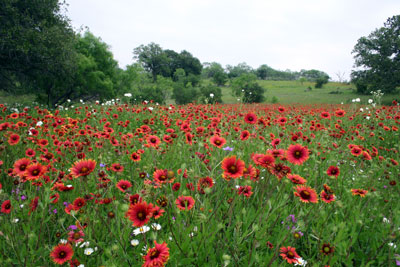 Outstanding displays of wildflowers are typical after an El Niño winter and spring in Central Texas. This photograph at the Double Helix Ranch is from 2007; we had similar displays of wildflowers in 2010, after our cool, wet El Niño winter. Spring and summer 2011 were quie another story, with pastures burned from a La Niña-induced drought. This article explains why we get great shows of wildflowers in central Texas some years, and much less impressive shows in other years.
Outstanding displays of wildflowers are typical after an El Niño winter and spring in Central Texas. This photograph at the Double Helix Ranch is from 2007; we had similar displays of wildflowers in 2010, after our cool, wet El Niño winter. Spring and summer 2011 were quie another story, with pastures burned from a La Niña-induced drought. This article explains why we get great shows of wildflowers in central Texas some years, and much less impressive shows in other years.
The Fly Gap Division of the Double Helix Ranch is located in central Texas, close to the geographical center of the state. The long-term average rainfall is about 26 inches per year (66 cm). However, an "average" year is quite rare. Instead, the ranch cycles regularly between wet periods (up to about double the average rainfall within a 12-month period) and dry periods (often as little as half the average rainfall). These wet-dry cycles are fairly regular, with "extreme" wet and dry periods occurring every three to five years (see the graph below):
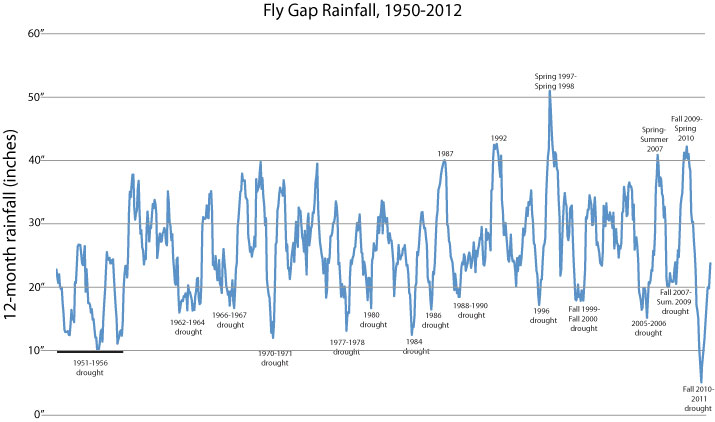
In this graph, each plotted point (one per month) shows the total rainfall for the previous 12 months. Since this 12-month moving sum always includes a full year, the cycles have no relationship to any seasonality (in other words, each 12-month period includes each of the months of January through December).
I have marked some of the major droughts and wet periods over the past 60 years. In particular, notice the severe drought of record in the early 1950s. Also, notice that the wettest wet periods have been in the past two decades, and that the 2010-2011 drought was the worst since the drought of record in the early 1950s (for a single year, October 2010 through September 2011 was the driest 12 months on record). The 1950s drought actually consisted of three droughts of similar intensity to the 2010-2011 drought in a row, with short periods of near-average precipitation in between each major dry period. Although our recent droughts have been compared in the news media to the drought of the early 1950s, the 1950s drought was much longer, more widespread, and severe (in terms of lack of rainfall) than any drought that we have experienced since (although the 2010-2011 drought was the worst one-year drought). For example, many major rivers in south and central Texas (such as the Llano River and the Medina River) stopped flowing or dried completely during the 1950s drought. These rivers have not stopped flowing again since then, despite much higher water use from growing human populations, although we came very close with the 2010-2011 drought. We are fortunate that most of our recent severe droughts were followed by very wet conditions (associated with El Niño episodes). For example, the 2005-2006 drought was followed by an El Niño episode in late 2006 through summer 2007, before the drought conditions returned in late 2007. Another very wet period (associated with another El Niño episode) in winter of 2009-2010 followed the drought of 2007-2009. We then experienced a weak El Niño that developed in late 2014, which helped us to recover from the 2010-2011drought. Then, like clockwork, another La Niña in 2017-2018 led to drought once again.
Some recent media reports suggest that some recent five-year periods (such as 2010-2015) were even drier than the drought of the early 1950s (1951-1956). This is certainly not true if we just consider rainfall. But in terms of water supply, the inflows into the Highland Lakes (which supply much of central Texas with drinking water) were indeed much lower in 2010-2015 than in the 1950s. If the rainfall has been higher, but the inflows are lower, where is all the water going? Much of the explanation is that human population size has exploded in Texas since the 1950s, and humans are using the water before it ever makes it into the Highland Lakes. In addition, changes in land management may also affect how much of the rainfall ends up as runoff. These factors suggest that modeling our "drought of record" on the 1950s drought may not make sense, at least for the purposes of water use and development.
These wet-dry cycles in central Texas are caused largely by the fluctuations in ocean temperatures in the equatorial Pacific Ocean (the El Niño Southern Oscillation). When the equatorial Pacific Ocean temperatures rise, rainfall in central Texas increases (especially from fall to spring). When these ocean temperatures fall, rainfall in central Texas decreases. Long periods of above-average Pacific Ocean temperatures are called El Niño episodes, and long periods of below average temperatures are called La Niña episodes. Specifically, the Ocean Niño Index (ONI) measures the departures in temperature from the long-term average in an area of the Pacific Ocean known as Niño 3.4. El Niño episodes are declared when the ONI is above 0.5 degrees (C) for five or more consecutive overlapping three-month periods, and La Niña episodes are declared when the ONI is below 0.5 degrees for five or more consecutive overlapping three-month periods. (If the ONI is above or below the 0.5 C range but it has not yet been there long enough to declare an El Niño or La Niña episode, then El Niño or La Niña conditions are said to exist.)
There are exceptions to the pattern of wet El Niño years and dry La Niña years, of course. Hurricanes also can have a major influence on our rainfall patterns in the summer and fall, and hurricanes tend to be suppressed in El Niño years and more active in La Niña years. However, research published in 2009 (Impact of shifting patterns of Pacific Ocean warming on north Atlantic tropical cyclones; Science 325: 77-80) suggests that there are actually two versions of El Niño episodes, depending on the exact location of the warmer water in the equatorial Pacific. In the classic version of an El Niño, the warming is in the eastern Pacific, and Atlantic hurricanes are less frequent. But in the variant El Niño, the warming is in the central Pacific, and Atlantic hurricanes are as frequent as they are in La Niña years. La Niña years tend to be dry in the winter and spring, but may get late summer/fall floods associated with hurricanes. El Niño years are often wet in the winter and spring. The wettest years of all come when we have an El Niño winter and spring, and then the El Niño breaks to allow an active hurricane season in the summer and fall. This latter pattern can also occur under the variant El Niño conditions, in which the warming occurs in the central Pacific.
The following graph from the NOAA/National Weather Service Climate Prediction Center shows the El Niño/La Niña cycles from 1950 to 2015:
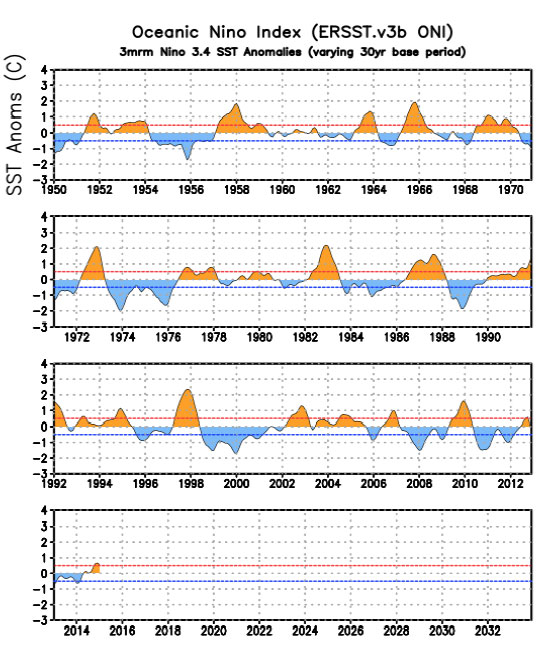
In the graph above, orange indicates El Niño conditions, and blue indicates La Niña conditions. If you compare the wet/dry cycles at Fly Gap to the El Niño/La Niña cycles, you will see that there is a close correlation. The long-lasting 2007-2009 drought resulted from a "double-dip" La Niña. Conditions briefly returned to near neutral in summer 2008, but then went right back into La Niña conditions in late 2008 and early 2009 (bringing back the drought conditions). In summer 2009, we returned to El Niño conditions, and a full El Niño episode developed in late 2009 (which produced our wet and cool winter of 2009-2010). Unfortunately, we had another double-dip La Niña in 2010-2011 (see more below).
Examples of the variant El Niño episodes, in which most of the warming was in the central Pacific (El Niño area 4) rather than in the eastern Pacific (El Niño area 3), include the El Niño episodes of 1969-1970, 1991-1992, 1994-1995, 2002-2003, and 2004-2005. These variant El Niño episodes appear to be becoming more common than the "typical" El Niño episodes. These episodes all increased our rainfall in central Texas in the expected pattern, sometimes breaking a drought in dramatic fashion with heavy tropical rainfall in the fall (e.g., the October to December rainfall for these five episodes was 13.23", 12.17", 10.75", 8.28", and 9.08", respectively, all of which are well above our average rainfall for these months of 6.86".)
If we plot the ONI against the rainfall deviation from the long-term average, on a month-by-month basis for the past 20 years, the correlation of the El Niño/La Niña conditions with rainfall in central Texas is quite clear:
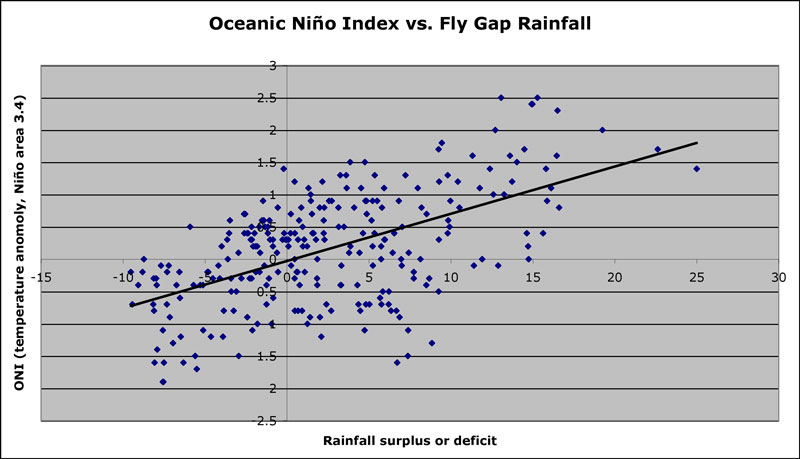
In particular, note that when the ONI is above 1.0, Fly Gap (located very close to the geographic center of Texas) is almost always wetter than the long-term average (there is a rainfall surplus). When the ONI is below -1.0, Fly Gap is likely to be in drought (a rainfall deficit, although this pattern is somewhat more variable). Some of the variation stems from the fact that El Niño episodes (when the ONI is high) tend to produce wet weather in central Texas from fall through spring, but drier than normal weather in the summers.
The NOAA/National Weather Service Climate Prediction Center presents the following map to describe the usual winter weather pattern that accompanies an El Niño episode. Notice that the Pacific Jet Stream brings wet, cooler weather over Texas:
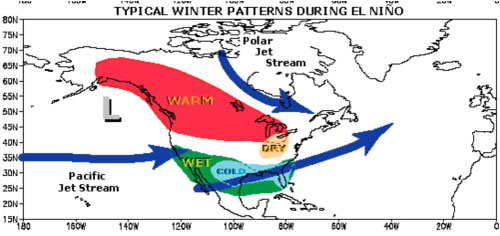
The usual wet winter pattern for an El Niño episode (as expected in central and south Texas) is somewhat less predictable in north or west Texas, and of course every El Niño episode does not necessarily bring wetter winter weather—it simply improves our chances for wet weather. The following maps (from the NOAA/National Weather Service Climate Prediction Center) show the average precipitation deviations for the past 18 El Niño episodes (on the left; green indicates higher than average precipitation), as well as the frequency of these expected deviations over the 18 El Niño episodes (on the right; blues indicate low frequency of occurrence, and oranges to reds indicate high frequency of occurrence). The first map is for the months of October to December, the middle map for the months of November to January, and the third map for the months of December to February. Although almost all of Texas tends to be wetter than normal in an El Niño episode, notice that the wet winter pattern is strongest and most predictable in south-central, south, and south-east Texas:
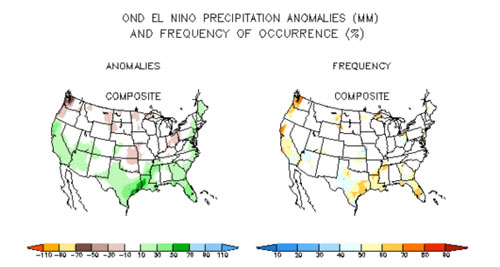
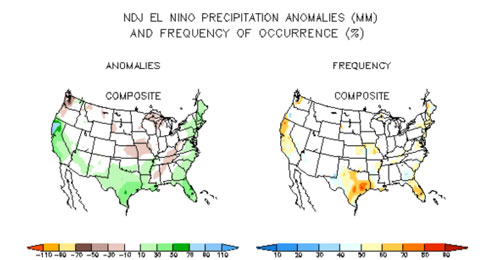
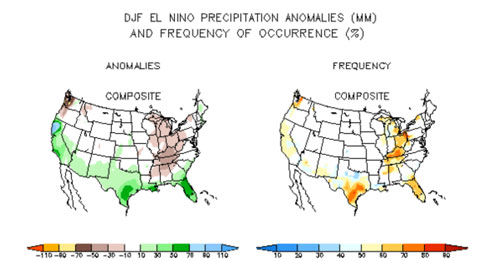
Are these patterns changing with global warming? From the graph of the El Niño/La Niña cycles and the graph of Fly Gap rainfall since 1950, notice that for the last 20 years, both the ONI and Fly Gap rainfall have tended to be above their long-term averages, consistent with the world-wide patterns of global warming. In fact, global warming may be responsible for a slow but consistent increase in our local average annual rainfall. In a graph of the 12-month running rainfall at Fly Gap since 1895 (when records begin), a gradual increase in average rainfall is apparent:
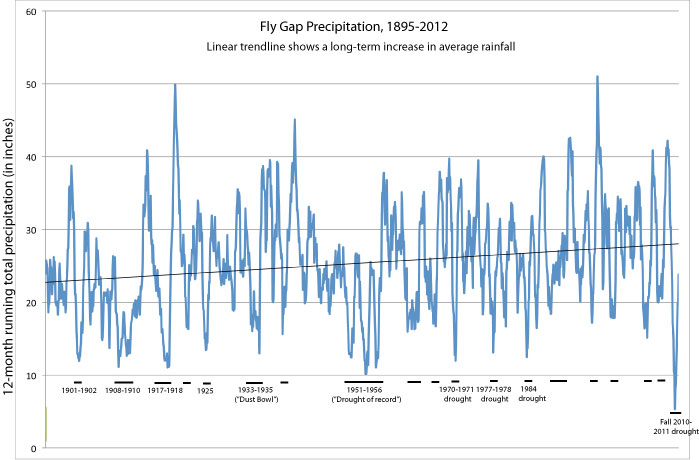
(See below for an update of this map).
Although the average across all these years is about 26 inches, note that the annual average has shifted upward by almost 5 inches since the late 1800s (from about 23 to 28 inches per year).
Will these long-term patterns continue in central Texas with increased global warming? There is considerable debate about that point, with different models showing different outcomes. A moderate degree of ocean warming is likely to increase El Niño events, which tend to make central Texas wetter. However, a major increase in temperatures could cause a shift in the Pacific jet stream, which supplies us with much of our moisture. An increase in temperature would increase evapotranspiration (if average wind speed remains constant), so it would take more rainfall to produce the same amount of soil moisture. However, worldwide increased evaporation also must lead to increased precipitation, since evaporation and precipitation have to be in equilibrium in the long term (otherwise, atmospheric moisture would continue to increase or decrease indefinitely). Some climate models predict increased variation in rainfall for the southwestern United States, which could increase the intensity of both droughts and floods. One recent analysis of the worldwide rainfall patterns over the past twenty years shows a slow but significant increase in global precipitation associated with global warming (How much more rain will global warming bring?; Science 317: 232-235; 2007). Although this is consistent with the effects seen locally in central Texas over the past few decades, the rainfall patterns in any one region could change quickly depending on a large number of climatic complexities. The bottom line is that the long-term predictions are all over the map for central Texas. The one thing that is clear is that global warming will produce major effects on precipitation patterns. Whether that means that central Texas will become wetter, drier, or more variable is not yet entirely clear, however. To date, recent global warming seems to have made central Texas wetter, but a switch point in the climate could end that trend suddenly.
The following graph from NOAA documents the reality of global warming, and how quickly and suddenly it is happening. Note that global temperatures have been consistently above average, and steadily rising, since about 1980. One can see the beginnings of this trend dating back to about 1940:
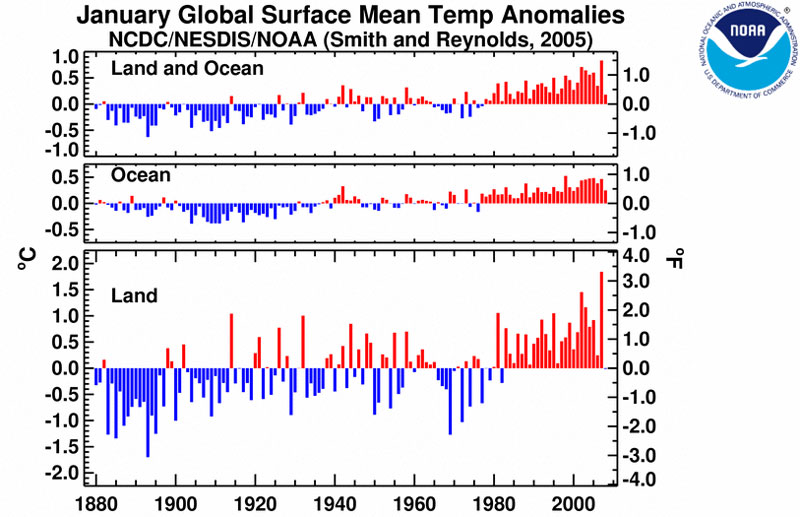
Getting back to the effects from El Niño/La Niña cycles: The effects of this cycle are particularly evident from fall through spring. If we compare El Niño years to La Niña years in central Texas, and look at the rainfall from October to March at Fly Gap, most El Niño years are wetter than average and most La Niña years are drier than average. In the following graph (based on data from Fly Gap from 1951-2009), El Niño years are shown in blue, and La Niña years in red:
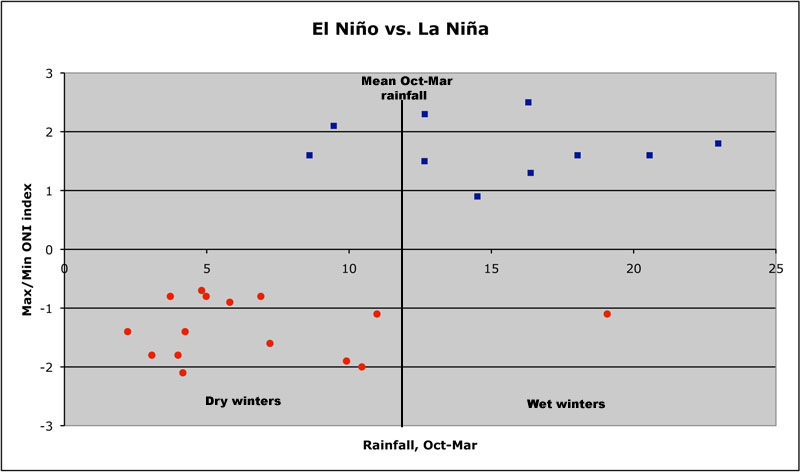
Note that almost all very wet years were El Niño years, and all the very dry years were La Niña years. Only two of ten El Niño winters were below average (the exceptions were 1965-1966 and 1972-1973), and only one of fifteen La Niña winters was above average (the exception was 1984-1985). The mean rainfall for El Niño winters is about three times the mean rainfall of La Niña winters. The recent La Niña winters of 2005-2006, 2007-2008, and 2008-2009, and 2010-2011all fit this pattern perfectly, with just 4.82", 4.24", 6.9", and 2.72" of rain from October to March in these four winters, respectively.
Update, 5 May 2022: Winter of 2021-2022 was another severe La Niña event
The winter of 2021-2022 was in another La Niña episode, so we expected a dry winter. That is exactly what happened, but it set a new record for low rainfall for a six-month period. In the last six months, we have received just 1.60" of rain (the lowest total for any six-month period since 1895). If conditions don't improve this year, we may be heading into another record drought for the year (to equal or exceed the drought of 2010-2011 in severity). The severity of the current drought is not yet obvious on the 12-month rainfall graph below because we had a relatively wet summer of 2021. Here is the update of the 12-month cummulative rainfall through April 2022:
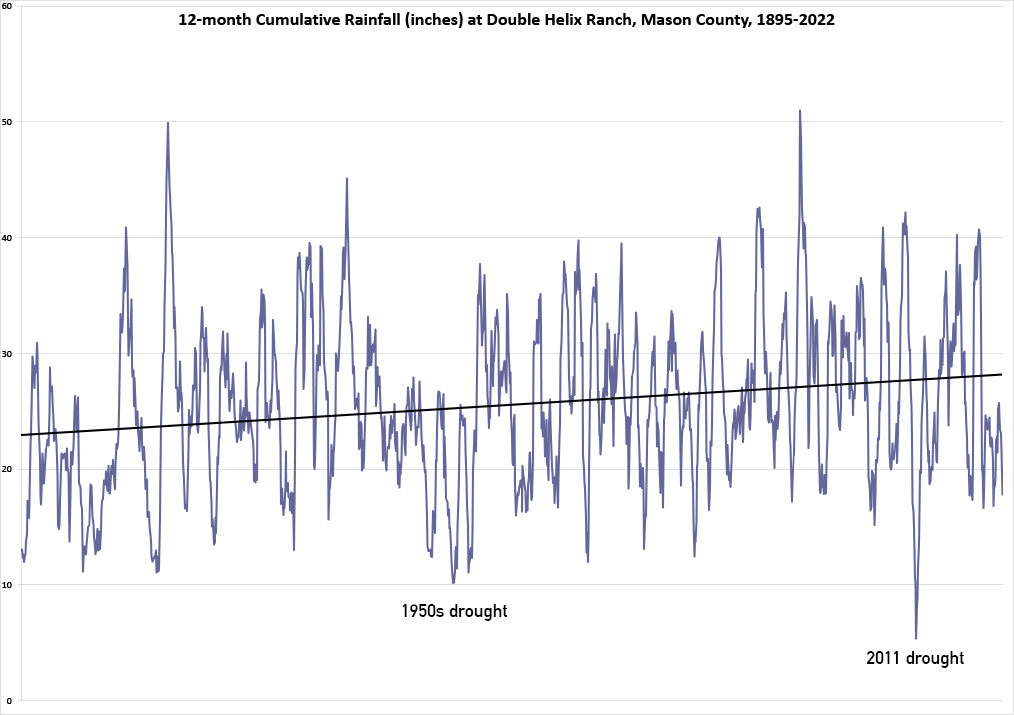
-----------------------------------------------------
For comments or queries, please contact:
David Hillis, Double Helix Ranch, DoubleHelixRanch@gmail.com